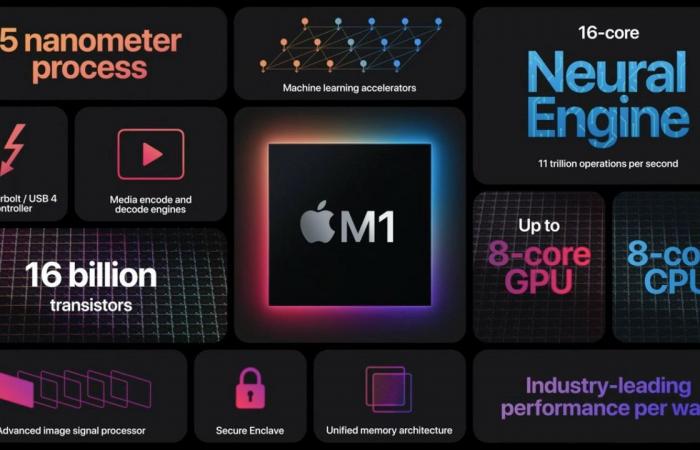The M1 is a system-on-chip processor (SoC), which means that the CPU, GPU and RAM are all on a single chip, just like Intel’s 11th generation Tiger Lake mobile processors and Apple’s A14 in its iPhone 12. This makes it possible each component a more efficient communication for faster processing times and lower latency and also reduces power consumption. The M1 chip is optimized for systems with low power consumption. This is a good thing, especially since some of the first products to feature the new M1 chips are the new MacBook Air and the new Mac Mini – two computers that rely on lower power consumption because there isn’t much room to cool, let alone from the fact that the new MacBook Air doesn’t even have a fan.
The rumors were true that the M1 was built on a 5nm node that is smaller than AMD’s 7nm chips and Intel’s 10nm and 14nm chips. Smaller nodes (transistors) are not only more energy efficient, but also more energy efficient. You can do more calculations per cycle without getting too hot. This is one of the main factors limiting CPU performance. The more transistors there are on a CPU, the faster it goes – twice as much data or more can be processed with more transistors at the same clock rate. The one in the M1 has 16 billion transistors; In comparison, AMD’s Zen 2 7nm architecture is 3.9 billion and Tiger Lake is 5 billion.
Another thing that would increase the M1’s performance is the number of raw cores. The M1 has been rumored to have a total of 12 CPU cores, eight of which are for high-performance workloads and four slower cores for tasks that don’t place nearly as heavy a load on the system (think video transcoding versus typing in Word). These rumors were not entirely true. The M1 will have eight cores in total, but four will be for performance workloads and the other four for high-efficiency workloads. Apple did not disclose the frequencies of these cores, however, merely claiming that they perform much better and consume less power than the “newest PC laptop chip.”
If we only work with transistors, then the M1 has beaten AMD and Intel. Ultimately, however, the number of transistors will depend on the general goals and design style of the CPU itself, so a chip with fewer transistors can still perform better depending on the rest of the design. So what the hell is Apple comparing the M1 to a PC laptop chip with?
These new Apple ARM benchmarks may not be what people think
New leaked benchmarks allegedly showing Apple’s developer transition kit running Geekbench 5 Pro natively on the Mac mini are making the rounds – in contrast to the previously leaked benchmarks where Geekbench 5 is virtually over on the transition kit Rosetta 2 was reportedly running …
Continue reading
If we look at the latest versions of the Mac Mini, MacBook Air, and MacBook Pro, both Mini and Air were 8th generation Intel. The Pro was the 10th generation. I assume Apple was talking about something like the Intel Core i7-1068NG7 in its 13-inch MacBook Pro, one of its mid-2020 models. In this processor, Intel uses what is known as Hyper-Threading, which doubles the number of threads compared to the total number of cores. This increases performance so that each core can execute two instruction streams at the same time instead of just one, so that twice as much information is processed. Intel also implements a so-called clock scaling on all cores, which automatically adapts to the executed workload.
The M1 does that too, but since it’s an ARM SoC, one half of the chip is usually active depending on the type of process the computer is doing, and it toggles between the halves on the fly. Instead of using all eight cores, as is the case with the i7-1068NG7 for core scaling, the M1 switches between the four “big” cores and the four “small” cores to adapt to changing workloads and conversation performance required. There are different approaches to solving the same problem, but without knowing the clock speeds of the M1 it is still difficult to make a definitive comparison between the M1 and the “newest pc laptop chip”.
However, the M1’s neural engine could give it an edge. Like Apple’s A14 Bionic chip for iPhones, the M1 also has a 16-core neural engine on the chip itself, which makes neural networks and machine learning more energy efficient than such tasks on the CPU or GPU alone. But not every job needs something like this.
We now have a better idea of how capable the M1 will be, but we still don’t have all the details. Only real life tests will show whether the M1 lives up to all of the claims Apple made today. This is a big moment for Apple and for the CPU world in general. We all hold our breath to see what happens.
These were the details of the news Resolving all Apple technical issues to understand the new M1 chip for this day. We hope that we have succeeded by giving you the full details and information. To follow all our news, you can subscribe to the alerts system or to one of our different systems to provide you with all that is new.
It is also worth noting that the original news has been published and is available at de24.news and the editorial team at AlKhaleej Today has confirmed it and it has been modified, and it may have been completely transferred or quoted from it and you can read and follow this news from its main source.

